 |
||
|
||
| ||
Month was long not only due to amount of days, but also due to amount of articles appeared in this section. Not to repeat myself, I'll stop only on the most significant moments of the past month, and I'll also make announcements. So, in December this "Mobile" section will be widened with a rubric devoted to DECT-phones, so, descriptions of these devices, manuals, and, certainly, reviews will appear soon. First, there will be reviews of Siemens 4010 Micro and Panasonic 725. As usually, send all wishes and comment to eldar@ixbt.com. October was remarkable with Smau ' 01 exhibition in Milan visited by your obedient servant who made a report about it. I'll just remind that some new products were shown at this exhibition, in particular, Sony Ericsson Mobile showed a new HBH-20 Bluetooth set. It is a usual Bluetooth module with 68x35x22 mm sizes and 29 grammes weight. Certainly, it requires a phone with Bluetooth support - just like one of those designed by company, for example, T39m or R520m. The device fully supports voice dialing and also allows to manage incoming and outgoing calls directly from the built-in control panel. HBH-20 works up to 4 hours in the active mode and up to 60 hours in the idle mode. Cases are silvery and dark-blue. HBH-20 has already appeared for sale in the beginning of November for about $300.  I'll also mark announcements of new Sony CMD-Z7, CMD-J7, CMD-J70 in October. Panasonic pleased admirers with clarified specifications of GD95 model and the official announcement of GD75 and GD76 models, the latter featuring GPRS support. In the meantime Motorola v70 was presented in Asia, being one of 5 devices of a new 2002 line. According to phone's features it's a continuation "v" line. Preliminary specifications are here. I'll note that the unusual Rotate principle was realized in a cellular telephone for the first time. Now to open the top cover one has to displace it by 180 degrees instead of flipping it as earlier. In addition the phone features changing screen edging, being a very unusual but extremely interesting solution. 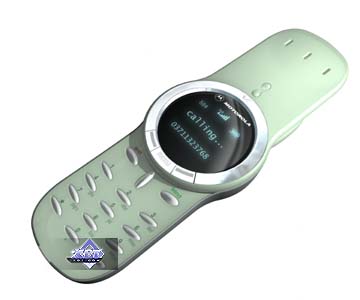 Other news from this company concerned maintenance of portable devices with alternative energy sources, like gas or just muscular force in general. In the first case the source is a fuel element working on methane. It is capable of energizing a cellular telephone for a month, but thus features large sizes of 10x5x1.25 cm and is to be fastened to a belt. Actually this fuel element must be connected to phone's charge socket to continuously recharge an accumulator; similar devices already exist, but, as a rule, they are for single use only. Actually Motorola not the only engaged in such development. For example, NEC and Sony, brand manufacturers of household electronics and computers, also look for ways of replacing modern batteries used in portable electronic devices. According to many analysts, mass distribution of fuel elements might be expected in 2-4 years, but Motorola itself says nothing about mass sales of its methane batteries. Still NEC plans to set mass production in 2003-2005. In the second case Motorola signed the agreement with British Freeplay Energy Group that has developed a "manual dynamo" anew. If your phone's accumulator is down, and there is no opportunity to charge it, just use a device reminding those of the beginning of the last century - a special handle connected to your phone. Just turn it for 45 seconds and you'll be able to make a 3-6 minutes call or to leave the phone in the idle mode. A new "charger" with dimensions of an average-sized phone will appear in American and European shops at the end of this year already. It will cost $60-70. Though this handle is created specially for Motorola devices, it will be also compatible with cellular telephones of other companies. Handspring, known by its PDAs and GSM-modules for them (VisorPhone), this time decided to kill two birds with one stone and released two new models - Treo 180 and Treo 180g. By and large, these are not usual PDAs, but communicators featuring a built-in GSM-module in usual palm-PDA cases along with external fixed antenna.  Strangely enough, but versions for the European market (GSM 900/1800, GSM 900/1900) have appeared first, and CDMA-version for USA is being developed just now. Treo 180 differs from Treo 180g by a built-in QWERTY keyboard as the second model features traditional nonkeyboard input. Sizes of the device are usual enough - 11x6.9x1.8 cm, and the weight is 153 grammes. PDA is based on Motorola Dragonball VX 33 MHZ processor, has 16 Mbytes memory, and ROM is patched with Palm OS 3.5.2H4 without possibility of future updates. The monochrome screen is standard with 160x160 resolution. A built-in Li-Ion battery allows, according to developers, to work up to 60 hours in the idle mode or up to 2.5 hours in the conversation mode. There is an opportunity of disconnecting GSM-component thus levelling operating time with that of other PDAs. Communicators feature rather weak vibroringers, but still it's better than nothing. Other features are: IR-port, USB PC-sync cable and the absence of SpringBoard slot making these PDAs closed books. Treo 180 (both models) are already for sale in USA for $550, price can be reduced down to $400 on subscription to cellular communication services, and there is also a discount for VisorPhone owners. Treo 270 model with a color screen for about $600 prospectively is expected to appear in the beginning of 2002.  Speaking about similar devices I'll mark accessories capable of transforming PDAs into smartphones. In October Swedish Etheraction announced the December release of an interesting device combining DAB (digital FM-radio) and GSM-phone capabilities designed for Compaq's iPAQ 3850 PDA. With the help of Etheraction Terminal users will be to access such Internet resources, as HTML documents, Flash-files, sound, MP3, video - both downloaded and streaming, etc. (Don't forget about integrated DAB receiver/decoder). Etheraction Terminal will cost about SEK 3995 (415 euros or $375). In October Nokia appealed to help socially unprotected population stratas. It has addressed several world brand designers with an unusual order of creating special panels for Nokia 8210 mobiles, all income to be used for charitable purposes. For example, the phone below was designed by Anya Hindmarch. DKNY design company offered citrus motives of lemon and lime, and Anthony Symonds made a phone look like a blue zebra. All panels were for sale at the online auction and were produced in a limited amount.  Siemens releases Limited Editions of its phones for a long time already, but not everybody knows it. The minimal order for such exclusive models is 1000 pieces that raises their price approximately by third. So, exclusive ME45 model costs about $400 instead of usual $300. Just look and enjoy. 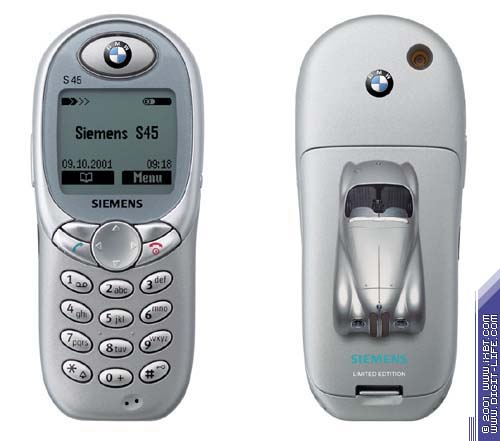  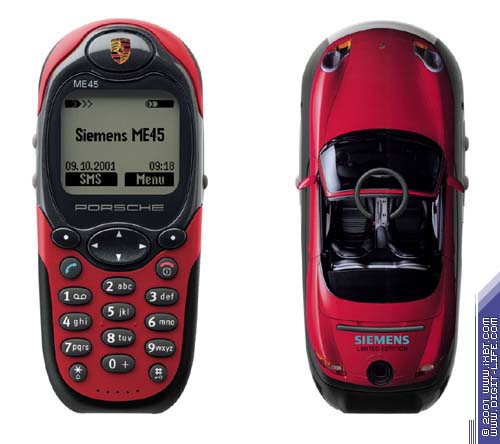 And a little-known novelty from Siemens in addition - the HomeStation device being an interface between a usual phone line and a mobile phone (C/M/S35 models with version 18 software and higher and also C/ME/S/SL45, SL42 mobiles are supported). The basic idea of this device is uniting all phones in a house into a single line thus allowing to receive cellular calls with a usual wire device. The work method is pretty simple: connect a cellular phone to HomeStation with a cable and the device itself - to a phone line. That's all. Now a usual home device (from analog to, for example, ISDN PBX) will be able to call via a cellular network or via a usual line. It is achieved with the help of a dialing phone number prefix. Incoming cellular calls go to a usual device as well, thus your house will be disturbed by a single phone device only. HomeStation is supplied with a cradle charger for a cellular telephone for recharging it at home. System disadvantage is that organizer events stop working on connecting a mobile to HomeStation, and it is also impossible to use a phone as a GSM-modem.  New servicesOctober was full of messages about cellular telephones and safety. American theme unexpectedly continued. I'll remind that according to the decision of Federal Communication Commission of USA mobile operators should have begun to sell telephones with a capability of locating subscribers sending emergency calls (E-911 technology) since the 1st of October. By the 31th of December sales of such phones are expected to make at least a quarter of total sales volumes. Besides, E-911 technology support along with global positioning systems (GPS) were supposed to be already integrated into networks of American mobile operators. However, the majority of companies has asked FCC about a delay in realization of this decision. Among them were Cingular Wireless, AT&T Wireless, Verizon Wireless and Qwest Wireless and others. Nancy Sherrer, Sprint PCS representative, said that the company had begun to sell "first in America mobile phones with GPS support", however embedding of E-911 technology into mobile networks requires precise and scale coordination of governmental and public efforts. Many companies named March, 2002 as the nearest date of launching E-911 support with their products or services. Nevertheless, the commission was uncompromising and set a $10000 penalty for every day of requirements nonfulfillment. This resulted in urgent integration of this service moving its quality aside. In the meantime European Europolitan Vodafone mobile operator informed about the planned launch of a similar service to Swedish cellular subscribers. Europolitan Vodafone promised full national coverage by the end of the year. Continuing the safety theme, I'll note that many users are carelessly concern warnings about switching off cellulars onboard planes. Norwegian ICE International is now testing a device that will automatically disconnect plane passengers' cellulars on pressing a single button in a cockpit. The device represents an antenna sending a radio-frequency switch off signal. According to the company, 240 international airports are already interested in the development, and preliminary tests results are very encouraging. But final tests results will be announced only the nearest spring. It is interesting that even an obsolete cellular telephone may be dangerous. Australian Telstra operator is going to support mobile phones processing enterprise, having placed bins for gathering old phones in 143 shops of Telstra trading network throughout Australia. Campaign for old mobile phones processing called Phones for Planet Ark is a joint initiative of Australian Mobile Telecommunications Association (AMTA) and Planet Ark. The campaign is purposed to annually collect and process 120 tons of mobile phones and accumulators. Gary Delport, CEO of Telstra Shops National, informed that according to AMTA 10 million unused mobile phones are kept in houses and offices throughout Australia. Bins for old devices are cleared monthly, and various phones components are processed for their further use, for example, for rustless process or manufacture of new accumulators, furniture, etc. I wonder how they might utilize such phones as below. 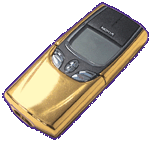 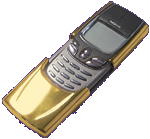 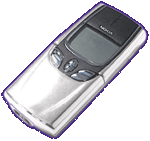 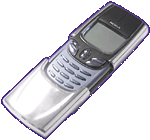 Above pictures show devices with cases made of 18-carat gold - about 75 grammes for each case. Silver color in the second case just means white gold. Such phones can be ordered on the web-site of Austrian jeweller Peter Aloisson. Unfortunately, the majority of models is not so modern, but I think that's not a problem. In addition, you can add brilliants to a case: e.g. one model features about 1200 jewels. Addressing to Peter Aloisson again you can hand him over an out-of-date phone for its valuable materials to be used in a case of a new device. Certainly, you'll have to pay for this additionally. And just a little about new services. British Quartez company presented Presendo freeware, allowing Internet users to send SMS messages to mobile phones from Microsoft Outlook. Presendo working in the network of London Olympia operator is capable of simultaneous sending of SMS to several mobile numbers. A free addition to this software allows to send messages to mobile phones of other British operators. First three messages are sent free, all following are paid for by credit cards on Quartez web-site. Company representatives are sure their brainchild will stimulate SMS service growth among business customers. The above is especially interesting as according to the review by Strand Consult company, the potential of SMS service in Europe is huge. If their amount in Italy, Great Britain, and Spain will grow at former rates, possible incomes of mobile operators from realization of these services in these countries can make 650.78, 588.83, and 455.61 million euro accordingly. Strand has also found out that subscribers and content providers will only benefit from operators' cooperation in sphere of these services. In this case content providers will get rid of necessity of delivering information to several operators simultaneously. Distribution of SMS services will also result in faster development of mobile communications of second (2G) and third (3G) generations. Write a comment below. No registration needed!
|
Platform · Video · Multimedia · Mobile · Other || About us & Privacy policy · Twitter · Facebook Copyright © Byrds Research & Publishing, Ltd., 1997–2011. All rights reserved. |